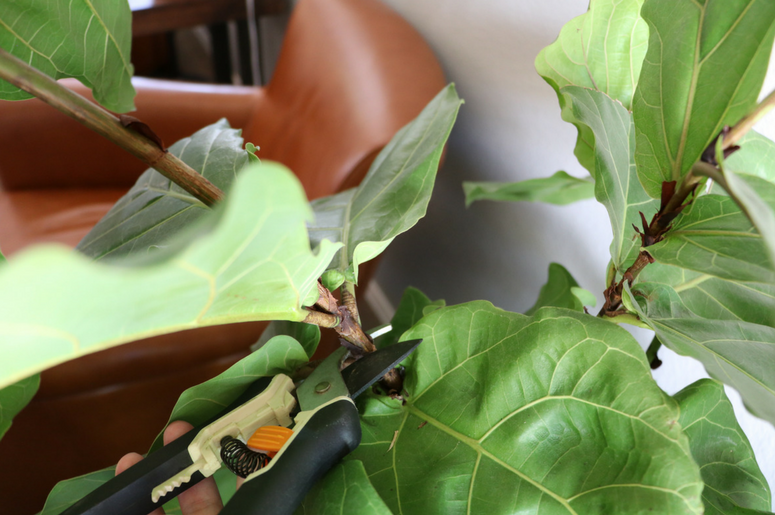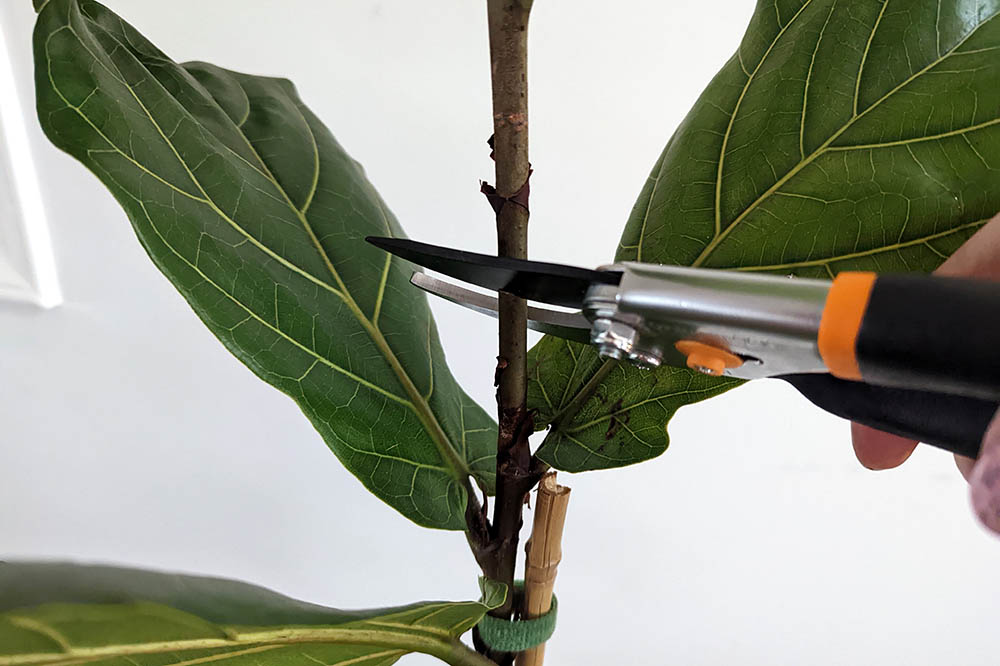
You may be horrified at the idea of cutting pieces off your Ficus, but don’t worry, because pruning is a normal part of caring for fiddle leaf fig trees. Keep in mind that these trees grow up to 50 feet tall in the wild, so they need to be trimmed to fit in your indoor living space.
Trimming your fiddle leaf is important not just for aesthetic reasons, but also to keep the plant healthy. Read on and let us show you the ropes on how to prune a fiddle leaf fig!
Understanding the Fiddle Leaf Fig
Your ficus lyrata is part of the fig tree family, which also includes edible figs and rubber trees. It’s native to hot regions near the equator in India and southern China. The leaves are large and fiddle-shaped, and some people easily mistake them for the majestic Elephant Ears plant. The whole plant contains latex (or sap) which is toxic to people and pets.
Pruning keeps the tree to an appropriate size, and there’s a way to do it that gives your tree a natural and appealing shape. Your tree can grow up to 2 feet per year, so you don’t want it bumping its head on the ceiling! It’s also important to know how to recognize diseased parts of your plant and how to remove them safely.
The Basics of Pruning
What you’ll need:
- A pair of pruning shears or a sharp knife
- Enough newspaper to cover the floor around the plant
- Rubber gloves
- Garbage can for the pruned leaves and branches
There are hows and whens for pruning figs:
- Prune in spring or early summer only. This gives the plant time to recover while it is actively growing.
- Don’t prune during winter. This is the plant’s dormant period, and any pruning done during this time of year will shock the plant.
- Always use pruning shears – never snap off leaves or branches by hand!
- Don’t prune off any leaves you don’t need to – the leaves are how the plant gathers energy through photosynthesis.
Step-by-Step Pruning Process
Before you start snipping away, take a look at your plant and think about the shape you want your tree to be, whether that’s a typical tree shape or a more compact bush. Also, identify any sick and diseased parts of the tree for removal.
- Clean and sterilize your pruning shears or knife.
- Cover the floor around the pot with newspaper. This will prevent the latex sap from getting on your floor.
- Put on your rubber gloves.
- Start pruning by removing any sick leaves and branches.
- Remove any other branches according to the shape you want.
- Collect the pruned parts and dispose of them. Clean up the newspaper and dispose of it. Don’t take off your gloves until the area is completely free of any latex residue – this latex is toxic!
Pruning Techniques
- Always trim between leaf nodes.
- Make your cuts diagonally rather than perpendicular to the branch.
- Don’t trim away any more than 10% of the tree at a time.
- Dispose of all your pruned pieces – don’t leave them laying around near the tree, since they may breed diseases over the following weeks or months.
- You can save pruned branches for propagation if you wish.
How to prune Fiddle Leaf Figs Step-by-Step

#1: Assessing the Fiddle Leaf Fig’s Growth
You can trim the tree to fit your space. If it’s bumping its head on the ceiling or creeping outward into a walkway, it’s time to prune. You also want to have space in between the branches for adequate airflow.
#2: Shaping Your Fiddle Leaf Fig Plant
You can cut the top off the plant – it’s recommended to prune no lower than 1/3 of the tree’s height down from the top. Trim lateral branches if necessary, but remember not to prune away more than 10% of the plant’s mass at one time.
#3: Removing Dead or Damaged Leaves
You can remove dead or diseased leaves at any time of the year. You should remove them sooner rather than later to prevent any infection from spreading. Removing diseased members is important for a healthy fiddle leaf fig.
#4: Promoting New Growth
By removing dead or crowding growth, you are creating more space for the plant to sprout new growth. Adding fertilizer after pruning will also encourage branching and the growth of new foliage.
Aftercare and Maintenance
Even after you’ve cleaned up after the pruning, you’re not quite done yet!
- Like any plant, you should water after pruning to reduce the shock the plant will experience.
- Good fertilizing will help preserve the overall health of the tree, as well as allow the tree to heal from the trimming.
Monitoring and Adjustments
If all went well, the tips of the branches you cut will sprout two new branches each, complete with new leaves.
Monitor your tree in the weeks following the pruning. Watch for signs of disease in the branches and leaves. If you sterilized your tools beforehand then you should be in the clear, but check to be sure.
As stated above, make sure you water the tree afterward to reduce the stress on the plant. Apply fertilizer so that the tree can put out some healthy growth, which will replace the limbs that you cut off.
Tips for Successful Pruning
- The latex (sap) of Ficus trees is toxic to people and pets. Protect your hands by wearing appropriate gloves and protect the floor by covering it with newspaper.
- Don’t trim more than 10% of the tree’s total mass away at one time.
- Don’t remove the leaves near the bottom of the tree unless they’re sick or damaged.
- Trim at a 45-degree angle, not perpendicular to the branch.
- Place the cuts between leaf nodes.
- Don’t forget to do your aftercare! That means watering and fertilizing, as well as clean-up.
Promoting Long-Term Growth and Aesthetics
If you trim your Ficus each year, it will grow into the shape you want. Keeping the tree down to size is important for its health as long as it’s kept indoors.
As indoor plants, they require regular fertilizing in order to stay healthy, especially after a trimming.
Of course, always prune away sick and damaged leaves and branches to ensure that the illnesses don’t spread.
To Sum it Up
Pruning is important to keep your fiddle leaf fig Ficus healthy! It’s part of the routine care of indoor Ficus trees. Make sure to follow the tips above and keep the latex off yourself! Best of luck and happy pruning!
Frequently Asked Questions
Yes, but you should only do this if your tree has outgrown its space and is hitting the ceiling. Leave roughly a foot of space between the ceiling and the top of the tree.
Where do you cut fiddle leaf branches?
Make the cuts between leaf nodes. Cut about half an inch away from the nearest leaf node, at least.
Should I cut the brown parts off my fiddle leaf fig?
Brown leaves may be a sign of underwatering. However, if the leaves appear diseased or develop soft brown spots, then yes, you should prune these off and dispose of them.
Will fiddle leaf fig leaves grow back?
Yes, leaves will grow back after pruning. Make sure you apply fertilizer to encourage your fiddle leaf fig to grow its leaves back.
How do you cut a fiddle leaf fig for growth?
Make the cut at a 45-degree angle to encourage the most growth. Be sure to fertilize the plant afterward.

